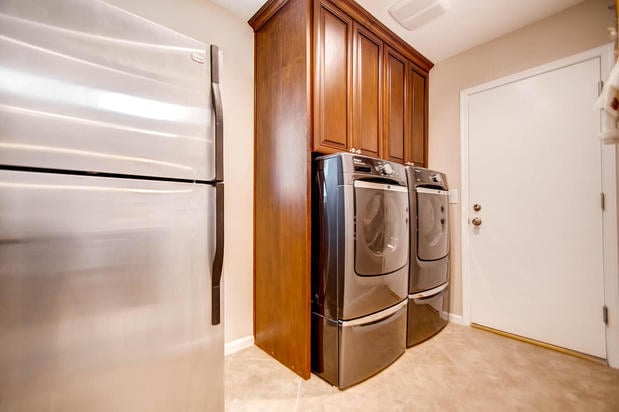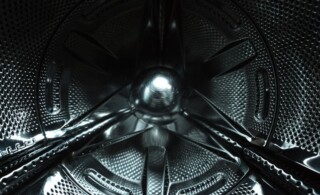On This Page:
If you are like most homeowners, you want your washing machine to work well without too much effort on your part. You expect to be able to put a load of clothes in your washer, set it to the appropriate wash setting, and let the washer do the rest.
However, sometimes that process can go awry. One of the most common washer problems that can occur is failure of the washer to drain correctly. The good news is that you can often narrow down the issue without too much difficulty.
Since your washing machine is filling with water correctly, you likely do not have to worry that the problem is your washing machine motor. Also, if your washing machine runs through a spin cycle, you can assume that your belt is okay.
Therefore, the reasons that your washer will not drain can usually be narrowed down to two possibilities: an obstruction of some kind in the drain hose or pump, or a pump failure.
Step-by-Step Guide to Repair a Washer
Your immediate goal is to get the water out of the washer, and your secondary goal is to repair the issue that is causing your washer not to drain. The following steps will help guide you through both processes.
1) Unplug your washer from its power supply.
2) Get the water out of the washer.
This can be done in a few different ways, depending on the amount of water in the washer and the way your washer is made. Here are some tips for removing excess water:
- Bail out as much water as possible, ladling it out into a handy bucket for disposal.
- Some washer models have a small drain tube on the front panel or on the kickplate of the washer. This small tube can be used to drain water slowly.
- For washers without this small tube or for times when a slow drain is not ideal, you can use gravity to drain out the water by propping one side of the washer up on wood blocks or bricks and using the drain hose to angle the water into a nearby drain or bucket.
3) If water does not drain from the hose, examine the hose for obstructions and pull out any debris to allow the water to flow freely.
4) Clamp the bottom of the hose closed to prevent additional leakage.
5) Remove the front panel by removing the screws that hold it in place.
6) Check the hose for obstructions.
Visually inspect the hose. If you find debris or an article of clothing in the hose, remove the obstruction. If there is no obstruction in the hose, proceed to the next step.
7) Check the pump for obstructions.
Generally, the housing on the pump is translucent, so you may be able to see any obvious obstruction. If you see the obstruction, remove the pump and hose from the washer, remove the belt from the pulley on the bottom side of the pump, and gently pull out the obstruction while turning the pulley by hand. If you do not see any obstruction in the pump itself, proceed to the next step.
8) Check the outlet where the hose connects to the bottom of the tub.
To check this outlet, loosen the clamp that holds the hose to the bottom of the tub and remove the hose. Look for any debris or clothing in the hose at the outlet base. Remove any obstruction you find. If you do not find an obstruction, it is likely that your pump has been damaged somehow.
If Your Washer Pump Has Failed
You washer pump can be damaged either by general wear and tear or because of debris that may be sucked into the pump and cause damage to its internal fins. In many cases, before a pump completely fails, you may hear unusual noises coming from your washer or notice leakage.
To check for damage caused by obstructive debris, you can insert your finger into the pump to feel for broken fins. If the fins are not broken, it may be that other internal pieces of your pump have failed due to wear.
You can replace the pump as a DIY project or hire a professional to replace it. If you choose the DIY option, you will need the brand and model number of your washer to find the correct replacement pump to use.
The model number of your washer is usually stamped on a small metal plate located under the tub lid, or on the top, side, or back of your washing machine. Once you find all the details on the metal plate, you can order a replacement pump online or go to your local appliance parts center.
When you find the correct pump, you can install it by attaching it with screws, connecting the hoses, and reinstalling the belt.
Some homeowners, however, decide that replacing the pump on their washing machines is a job best left to a professional. If you choose to let a pro handle this for you, remember to use a licensed, bonded, and fully insured professional to ensure that the quality of workmanship is superior and the work is guaranteed.
The Bottom Line
Since your washer is one of the most important appliances in your home, it is wise to understand what to do when your washer will not drain. Whether you choose to tackle the project yourself or hire a pro to help you, it is important to handle washer repairs as soon as possible to minimize the damage to your washing machine and ensure your comfort and convenience.

 Types of Stackable Washers and Dryers
Types of Stackable Washers and Dryers  Washing Machines and Clothes Dryers
Washing Machines and Clothes Dryers  DIY Guide: Replacing a Washer Pump
DIY Guide: Replacing a Washer Pump  Garbage Disposal Cleaning: Show Your Garbage Disposal Who Is Boss
Garbage Disposal Cleaning: Show Your Garbage Disposal Who Is Boss 

It’s interesting how appliance repairs can often be a do it yourself project. My husband and I were given a washer for free but it had a broken pump and wouldn’t drain. After doing a bit of research and ordering the part he was able to fix it himself in a couple hours. If you aren’t comfortable with that you can always call a professional to come do the repairs for you.